Synoptic and Regional Meteorological Drivers of a Wildfire in the Wildland–Urban Interface of Faro (Portugal)
Abstract
1. Introduction
2. Materials and Methods
2.1. Case Study
2.2. Large-Scale Meteorological Fields
2.3. Mesoscale Atmospheric Environment
2.4. Back-Trajectories
3. Results
3.1. Large-Scale Circulation
3.2. Mesoscale Circulation
3.3. Backward Trajectories
3.4. Fire Weather Index
4. Discussion
5. Conclusions
Author Contributions
Funding
Institutional Review Board Statement
Informed Consent Statement
Data Availability Statement
Acknowledgments
Conflicts of Interest
Appendix A
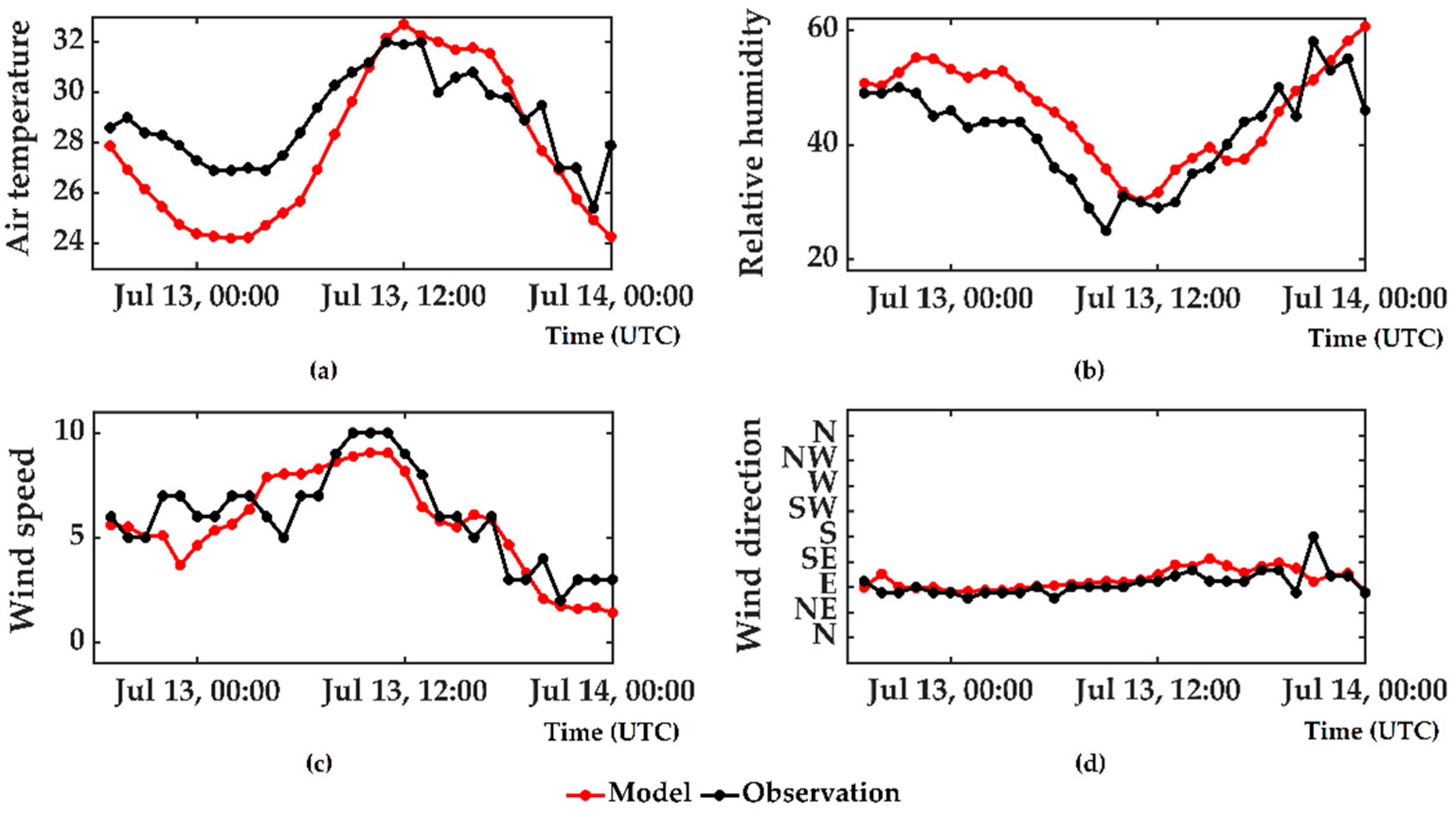
References
- Resco de Dios, V.; Schütze, S.J.; Camprubí, A.C.; Balaguer-Romano, R.; Boer, M.M.; Paulo, M.; Fernandes, P.M. Protected areas as hotspots of wildfire activity in fire-prone Temperate and Mediterranean biomes. J. Environ. Manag. 2025, 385, 125669. [Google Scholar] [CrossRef]
- Couto, F.T.; Santos, F.L.M.; Campos, C.; Andrade, N.; Purificação, C.; Salgado, R. Is Portugal Starting to Burn All Year Long? The Transboundary Fire in January 2022. Atmosphere 2022, 13, 1677. [Google Scholar] [CrossRef]
- Mendonça, J.M.; Mágoas, C. Relatório Final do Grupo de Peritos dos Incêndios Rurais; AGIF: Lisboa, Portugal, 2023; Available online: https://www.agif.pt/app/uploads/2023/04/Relat%C3%B3rio-Final-do-Grupo-de-Peritos-dos-Inc%C3%AAndios-Rurais.pdf (accessed on 25 June 2025).
- Almeida, M.; Soviev, M.; San-Miguel, J.; Durrant, T.; Oom, D.; Branco, A.; Ferrari, D.; Boca, R.; Maianti, P.; de Rigo, D.; et al. Report on the Large Wildfires of 2022 in Europe; Publications Office of the European Union: Luxembourg, 2024. [Google Scholar] [CrossRef]
- Mose, I.; Weixlbaumer, N. A new paradigm for protected areas in Europe? In Protected Areas and Regional Development in Europe; Mose, I., Ed.; Ashgate Publishing: Hampshire, UK, 2007; pp. 3–20. [Google Scholar]
- Andrade, N.; Couto, F.T.; Serra, J. Assessing Fire Risk Perception in the Vale do Guadiana Natural Park, Portugal. Fire 2023, 6, 243. [Google Scholar] [CrossRef]
- Radeloff, V.C.; Helmers, D.P.; Kramer, H.A.; Mockrin, M.H.; Alexandre, P.M.; Bar-Massada, A.; Butsic, V.; Hawbaker, T.J.; Martinuzzi, S.; Syphard, A.D.; et al. Rapid growth of the US wildland-urban interface raises wildfire risk. Proc. Natl. Acad. Sci. USA 2018, 115, 3314–3319. [Google Scholar] [CrossRef] [PubMed]
- Modaresi Rad, A.; Abatzoglou, J.T.; Kreitler, J.; Alizadeh, M.R.; AghaKouchak, A.; Hudyma, N.; Nauslar, N.J.; Sadegh, M. Human and infrastructure exposure to large wildfires in the United States. Nat. Sustain. 2023, 6, 1343–1351. [Google Scholar] [CrossRef]
- Aguirre, P.; León, J.; González-Mathiesen, C.; Román, R.; Penas, M.; Ogueda, A. Modelling the vulnerability of urban settings to wildland–urban interface fires in Chile. Nat. Hazards Earth Syst. Sci. 2024, 24, 1521–1537. [Google Scholar] [CrossRef]
- Li, P.; Zhao, B.; Soga, K.; Comfort, L. Exploring Wildfire Evacuation Strategies for Diverse Communities. Transp. Res. Rec. 2024, 2678, 719–735. [Google Scholar] [CrossRef]
- Raei, B.; Kinateder, M.; Bénichou, N.; Gomaa, I.; Wang, X. Are the data good enough? Spatial and temporal modeling of evacuee behavior using GPS data in a small rural community. Int. J. Disaster Risk Reduct. 2025, 116, 105054. [Google Scholar] [CrossRef]
- Ramos, C.; Yuan, Y. Neighborhood-Scale Wildfire Evacuation Vulnerability in Hays County, TX. Geographies 2024, 4, 481–499. [Google Scholar] [CrossRef]
- Zhang, W.; Wang Simon, S.-Y.; Chikamoto, Y.; Gillies, R.; LaPlante, M.; Hari, V. A weather pattern responsible for increasing wildfires in the western United States. Environ. Res. Lett. 2025, 20, 14007. [Google Scholar] [CrossRef]
- Tomshin, O.; Solovyev, V. Synoptic Weather Patterns during Fire Spread Events in Siberia. Sci. Total Environ. 2024, 921, 171205. [Google Scholar] [CrossRef] [PubMed]
- Ruffault, J.; Moron, V.; Trigo, R.M.; Curt, T. Daily synoptic conditions associated with large fire occurrence in Mediterranean France: Evidence for a wind-driven fire regime. Int. J. Climatol. 2017, 37, 524–533. [Google Scholar] [CrossRef]
- Papavasileiou, G.; Giannaros, T.M. Synoptic-Scale Drivers of Fire Weather in Greece. Sci. Total Environ. 2024, 925, 171715. [Google Scholar] [CrossRef] [PubMed]
- Little, K.; Castellanos-Acuna, D.; Jain, P.; Graham, L.; Kettridge, N.; Flannigan, M. Persistent positive anomalies in geopotential heights drive enhanced wildfire activity across Europe. Phil. Trans. R. Soc. B 2025, 380, 20230455. [Google Scholar] [CrossRef]
- Wu, M.; Zhang, C.; Li, M.; Du, W.; Chen, J.; Zhao, C. Self-Organizing Map-Based Classification for Fire Weather Index in the Beijing–Tianjin–Hebei Region and Their Potential Causes. Atmosphere 2025, 16, 403. [Google Scholar] [CrossRef]
- Bai, M.; Zhang, P.; Xing, P.; Du, W.; Hao, Z.; Zhang, H.; Shi, Y.; Liu, L. Spatiotemporal Characteristics, Causes, and Prediction of Wildfires in North China: A Study Using Satellite, Reanalysis, and Climate Model Datasets. Remote Sens. 2025, 17, 1038. [Google Scholar] [CrossRef]
- da Silva Nascimento, A.L.; da Silva Teixeira, M.; Alonso, M.F.; Nunes, A.B.; Laureanti, N.C.; Javarini, L.P. Synoptic patterns associated with the occurrence of fire foci in the Ecological Station Taim and Campos Neutrais—Brazil. Rev. Bras. de Climatol. 2023, 32, 463–493. [Google Scholar] [CrossRef]
- Keikhosravi, G.; Dizaj, A.Y. Investigation of synoptic patterns of fire occurrence in the forests of the western Alborz Mountains. Theor. Appl Clim. 2023, 154, 1151–1163. [Google Scholar] [CrossRef]
- Couto, F.T.; Kartsios, S.; Lacroix, M.; Andrade, H.N. A Quick Look at the Atmospheric Circulation Leading to Extreme Weather Phenomena on a Continental Scale. Atmosphere 2024, 15, 1205. [Google Scholar] [CrossRef]
- Rolinski, T.; Capps, S.B.; Zhuang, W. Santa Ana Winds: A Descriptive Climatology. Weather Forecast. 2019, 34, 257–275. [Google Scholar] [CrossRef]
- Cao, Y.; Fovell, R.G. Downslope Windstorms of San Diego County. Part I: A Case Study. Mon. Weather Rev. 2016, 144, 529–552. [Google Scholar] [CrossRef]
- Raphael, M.N. The Santa Ana Winds of California. Earth Interact. 2003, 7, 1–13. [Google Scholar] [CrossRef]
- Abatzoglou, J.T.; Barbero, R.; Nauslar, N.J. Diagnosing Santa Ana Winds in Southern California with Synoptic-Scale Analysis. Weather Forecast. 2013, 28, 704–710. [Google Scholar] [CrossRef]
- Keeley, J.E.; Guzman-Morales, J.; Gershunov, A.; Syphard, A.D.; Cayan, D.; Pierce, D.W.; Flannigan, M.; Brown, T.J. Ignitions explain more than temperature or precipitation in driving Santa Ana wind fires. Sci. Adv. 2021, 7, eabh2262. [Google Scholar] [CrossRef] [PubMed]
- Moritz, M.A.; Moody, T.J.; Krawchuk, M.A.; Hughes, M.; Hall, A. Spatial variation in extreme winds predicts large wildfire locations in chaparral ecosystems, Geophys. Res. Lett. 2010, 37, L04801. [Google Scholar] [CrossRef]
- Billmire, M.; French, N.H.F.; Loboda, T.; Owen, R.C.; Tyner, M. Santa Ana winds and predictors of wildfire progression in southern California. Int. J. Wildland Fire 2014, 23, 1119–1129. [Google Scholar] [CrossRef] [PubMed]
- Agyakwah, W.; Lin, Y.-L.; Kaplan, M.L. Essential Organizing and Evolving Atmospheric Mechanisms Affecting the East Bay Hills Fire in Oakland, California (1991). Fire 2025, 8, 72. [Google Scholar] [CrossRef]
- Smith, C.; Hatchett, B.J.; Kaplan, M. A Surface Observation Based Climatology of Diablo-Like Winds in California’s Wine Country and Western Sierra Nevada. Fire 2018, 1, 25. [Google Scholar] [CrossRef]
- Wiles, J.T.; Lin, Y.L.; Kaplan, M.L. Multi-scale numerical simulations of the synoptic environment, Diablo windstorm, and wildfire formation mechanisms for the Tubbs Fire (2017). Meteorol. Atmos. Phys. 2024, 136, 5. [Google Scholar] [CrossRef]
- Coen, J.L.; Schroeder, W.; Quayle, B. The Generation and Forecast of Extreme Winds during the Origin and Progression of the 2017 Tubbs Fire. Atmosphere 2018, 9, 462. [Google Scholar] [CrossRef]
- Montecinos, A.; Muñoz, R.C.; Oviedo, S.; Martínez, A.; Villagrán, V. Climatological Characterization of Puelche Winds down the Western Slope of the Extratropical Andes Mountains Using the NCEP Climate Forecast System Reanalysis. J. Appl. Meteorol. Climatol. 2017, 56, 677–696. [Google Scholar] [CrossRef]
- McWethy, D.B.; Garreaud, R.D.; Holz, A.; Pederson, G.T. Broad-Scale Surface and Atmospheric Conditions during Large Fires in South-Central Chile. Fire 2021, 4, 28. [Google Scholar] [CrossRef]
- Tomašević, I.C.; Fox-Hughes, P.; Cheung, K.K.W.; Beggs, P.J.; Vučetić, V.; Marsden-Smedley, J.; Telišman Prtenjak, M. Meteorological analysis of an extreme pyroconvective wildfire at Dunalley-Forcett, Australia. Nat. Hazards 2025, 121, 10843–10875. [Google Scholar] [CrossRef]
- Kartsios, S.; Karacostas, T.; Pytharoulis, I.; Dimitrakopoulos, A.P. Numerical investigation of atmosphere-fire interactions during high-impact wildland fire events in Greece. Atmos. Res. 2020, 247, 105253. [Google Scholar] [CrossRef]
- Tedim, F.; Remelgado, R.; Borges, C.; Carvalho, S.; Martins, J. Exploring the Occurrence of Mega-Fires in Portugal. For. Ecol. Manag. 2013, 294, 86–96. [Google Scholar] [CrossRef]
- Freire, J.G.; DaCamara, C.C. Using cellular automata to simulate wildfire propagation and to assist in fire management. Nat. Hazards Earth Syst. Sci. 2019, 19, 169–179. [Google Scholar] [CrossRef]
- Oliveira, T.M.; Barros, A.M.G.; Ager, A.A.; Fernandes, P.M. Assessing the effect of a fuel break network to reduce burnt area and wildfire risk transmission. Int. J. Wildland Fire 2016, 25, 619–632. [Google Scholar] [CrossRef]
- Santos, F.L.M.; Couto, F.T.; Dias, S.S.; Ribeiro, N.d.A.; Salgado, R. Vegetation Fuel Characterization Using Machine Learning Approach over Southern Portugal. Remote Sens. Appl. 2023, 32, 101017. [Google Scholar] [CrossRef]
- Purificação, C.; Santos, F.L.M.; Henkes, A.; Kartsios, S.; Couto, F.T. Fire-weather conditions during two fires in Southern Portugal: Meteorology, Orography, and Fuel Characteristics. Model. Earth Syst. Environ. 2025, 11, 135. [Google Scholar] [CrossRef]
- Purificação, C.; Campos, C.; Henkes, A.; Couto, F.T. Exploring the atmospheric conditions increasing fire danger in the Iberian Peninsula. Q. J. R. Meteorol. Soc. 2024, 150, 3475–3494. [Google Scholar] [CrossRef]
- Purificação, C.; Henkes, A.; Kartsios, S.; Couto, F.T. The Role of Atmospheric Circulation in Favouring Forest Fires in the Extreme Southern Portugal. Sustainability 2024, 16, 6985. [Google Scholar] [CrossRef]
- ECMWF/MARS. 2025. Available online: https://www.ecmwf.int/en/forecasts/access-forecasts/access-archive-datasets (accessed on 23 June 2025).
- Lac, C.; Chaboureau, J.-P.; Masson, V.; Pinty, J.-P.; Tulet, P.; Escobar, J.; Leriche, M.; Barthe, C.; Aouizerats, B.; Augros, C.; et al. Overview of the Meso-NH model version 5.4 and its applications. Geosci. Model Dev. 2018, 11, 1929–1969. [Google Scholar] [CrossRef]
- Pergaud, J.; Masson, V.; Malardel, S.; Couvreux, F. A Parameterization of Dry Thermals and Shallow Cumuli for Mesoscale Numerical Weather Prediction. Bound. Lay. Meteorol. 2009, 132, 83–106. [Google Scholar] [CrossRef]
- Pinty, J.-P.; Jabouille, P. A mixed-phase cloud parameterization for use in mesoscale non-hydrostatic model: Simulations of a squall line and of orographic precipitations. In Proceedings of the Conference on Cloud Physics, Everett, WA, USA, 17–21 August 1998; American Meteorological Society: Boston, MA, USA, 1999; pp. 217–220. [Google Scholar]
- Mlawer, E.J.; Taubman, S.J.; Brown, P.D.; Iacono, M.J.; Clough, S.A. Radiative transfer for inhomogeneous atmospheres: RRTM, a validated correlated-k model for the longwave. J. Geophys. Res. 1997, 102, 16663–16682. [Google Scholar] [CrossRef]
- Cuxart, J.; Bougeault, P.; Redelsperger, J.L. A turbulence scheme allowing for mesoscale and large-eddy simulations. Q. J. R. Meteorol. Soc. 2000, 126, 1–30. [Google Scholar] [CrossRef]
- Masson, V.; Le Moigne, P.; Martin, E.; Faroux, S.; Alias, A.; Alkama, R.; Belamari, S.; Barbu, A.; Boone, A.; Bouyssel, F.; et al. The SURFEXv7.2 land and ocean surface platform for coupled or offline simulation of earth surface variables and fluxes. Geosci. Model Dev. 2013, 6, 929–960. [Google Scholar] [CrossRef]
- SRTM. Available online: https://www.earthdata.nasa.gov/data/alerts-outages/shuttle-radar-topography-mission-version-3-0-srtm-plus-product-release (accessed on 24 June 2025).
- OGIMET. Available online: www.ogimet.com (accessed on 1 September 2025).
- Wagner, C.E. Development and structure of the Canadian Forest Fire Weather Index System. In Forestry Technical Report. 35; Canadian Forest Service, Petawawa National Forestry Institute: Chalk River, ON, Canada, 1987; 37p. [Google Scholar]
- IPMA. Perigo de Incêndio Rural—Índice Meteorológico de Incêndio [FWI]. 2025. Available online: https://www.ipma.pt/pt/enciclopedia/otempo/risco.incendio/index.jsp (accessed on 24 June 2025).
- IPMA. Relatório Julho 2022. Incêndios Rurais. Análise meteorológica & Índices de Perigo e de Risco. IPMA, Lisbon. 2022. Available online: https://www.ipma.pt/resources.www/docs/im.publicacoes/edicoes.online/20220920/aLPaHsIyJXBPjLidMnfC/met_20220701_20220731_fog_mm_co_pt.pdf (accessed on 24 June 2025).
- Copernicus Climate Change Service, Climate Data Store. Fire Danger Indices Historical Data from the Copernicus Emergency Management Service; Copernicus Climate Change Service (C3S) Climate Data Store (CDS): Bologna, Italy, 2019. [Google Scholar] [CrossRef]
- Stein, A.F.; Draxler, R.R.; Rolph, G.D.; Stunder, B.J.B.; Cohen, M.D.; Ngan, F. NOAA’s HYSPLIT atmospheric transport and dispersion modeling system, Bull. Amer. Meteor. Soc. 2015, 96, 2059–2077. [Google Scholar] [CrossRef]
- HYSPLIT. 2025. Available online: https://www.ready.noaa.gov/hypub-bin/trajtype.pl?runtype=archive (accessed on 23 June 2025).
- Purificação, C.; Andrade, N.; Potes, M.; Salgueiro, V.; Couto, F.T.; Salgado, R. Modelling the Atmospheric Environment Associated with a Wind-Driven Fire Event in Portugal. Atmosphere 2022, 13, 1124. [Google Scholar] [CrossRef]
- Lima, D.C.A.; Soares, P.M.M.; Nogueira, M.; Semedo, A. Global Coastal Low-Level Wind Jets Revisited through the New ERA5 Reanalysis. Int. J. Climatol. 2021, 42, 4491–4507. [Google Scholar] [CrossRef]
- Trigo, R.M.; Sousa, P.M.; Pereira, M.G.; Rasilla, D.; Gouveia, C.M. Modelling wildfire activity in Iberia with different atmospheric circulation weather types. Int. J. Clim. 2016, 36, 2761–2778. [Google Scholar] [CrossRef]
- Pereira, M.G.; Trigo, R.M.; da Camara, C.C.; Pereira, J.M.C.; Leite, S.M. Synoptic patterns associated with large summer forest fires in Portugal. Agric. For. Meteorol. 2006, 129, 11–25. [Google Scholar] [CrossRef]
- Couto, F.T.; Salgado, R.; Guiomar, N. Forest Fires in Madeira Island and the Fire Weather Created by Orographic Effects. Atmosphere 2021, 12, 827. [Google Scholar] [CrossRef]
- Couto, F.T.; Cardoso, E.H.C.; Costa, M.J.; Salgado, R.; Guerrero-Rascado, J.L.; Salgueiro, V. How a mesoscale cyclonic vortex over Sahara leads to a dust outbreak in South-western Iberia. Atmos. Res. 2021, 249, 105302. [Google Scholar] [CrossRef]
- Francis, D.; Eayrs, C.; Chaboureau, J.-P.; Mote, T.; Holland, D.M. A meandering polar jet caused the development of a Saharan cyclone and the transport of dust toward Greenland. Adv. Sci. Res. 2019, 16, 49–56. [Google Scholar] [CrossRef]
- López-Cayuela, M.Á.; Córdoba-Jabonero, C.; Bermejo-Pantaleón, D.; Sicard, M.; Salgueiro, V.; Molero, F.; Carvajal-Pérez, C.V.; Granados-Muñoz, M.J.; Comerón, A.; Couto, F.T.; et al. Vertical characterization of fine and coarse dust particles during an intense Saharan dust outbreak over the Iberian Peninsula in springtime 2021. Atmos. Chem. Phys. 2023, 23, 143–161. [Google Scholar] [CrossRef]
- Sharples, J.J.; Hilton, J.E. Modeling vorticity-driven wildfire behavior using near-field techniques. Front. Mech. Eng. 2020, 5, 69. [Google Scholar] [CrossRef]
- Lareau, N.P.; Nauslar, N.J.; Bentley, E.; Roberts, M.; Emmerson, S.; Brong, B.; Mehle, M.; Wallman, J. Fire-Generated Tornadic Vortices. Bull. Am. Meteorol. Soc. 2022, 103, E1296–E1320. [Google Scholar] [CrossRef]
- Couto, F.T.; Filippi, J.-B.; Baggio, R.; Campos, C.; Salgado, R. Triggering Pyro-Convection in a High-Resolution Coupled Fire–Atmosphere Simulation. Fire 2024, 7, 92. [Google Scholar] [CrossRef]
- Becken, S.; Hay, J.E. Tourism and Climate Change: Risks and Opportunities; Channel View Publications: Bristol, UK, 2012. [Google Scholar] [CrossRef]
- Espiner, S.; Orchiston, C.; Higham, J. Resilience and sustainability: A complementary relationship? J. Sustain. Tour. 2017, 25, 1385–1400. [Google Scholar] [CrossRef]
- UNWTO. Tourism and Resilience: Building Forward Better; World Tourism Organization: Madrid, Spain, 2022; Available online: https://www.worldbank.org/en/events/2021/03/24/tourism-resilience-building-forward-better (accessed on 24 June 2025).
- Gonzalez-Mathiesen, C.; Ruane, S.; March, A. Integrating Wildfire Risk Management and Spatial Planning—A Historical Review of Two Australian Planning Systems. Int. J. Disaster Risk Reduct. 2021, 53, 101984. [Google Scholar] [CrossRef]
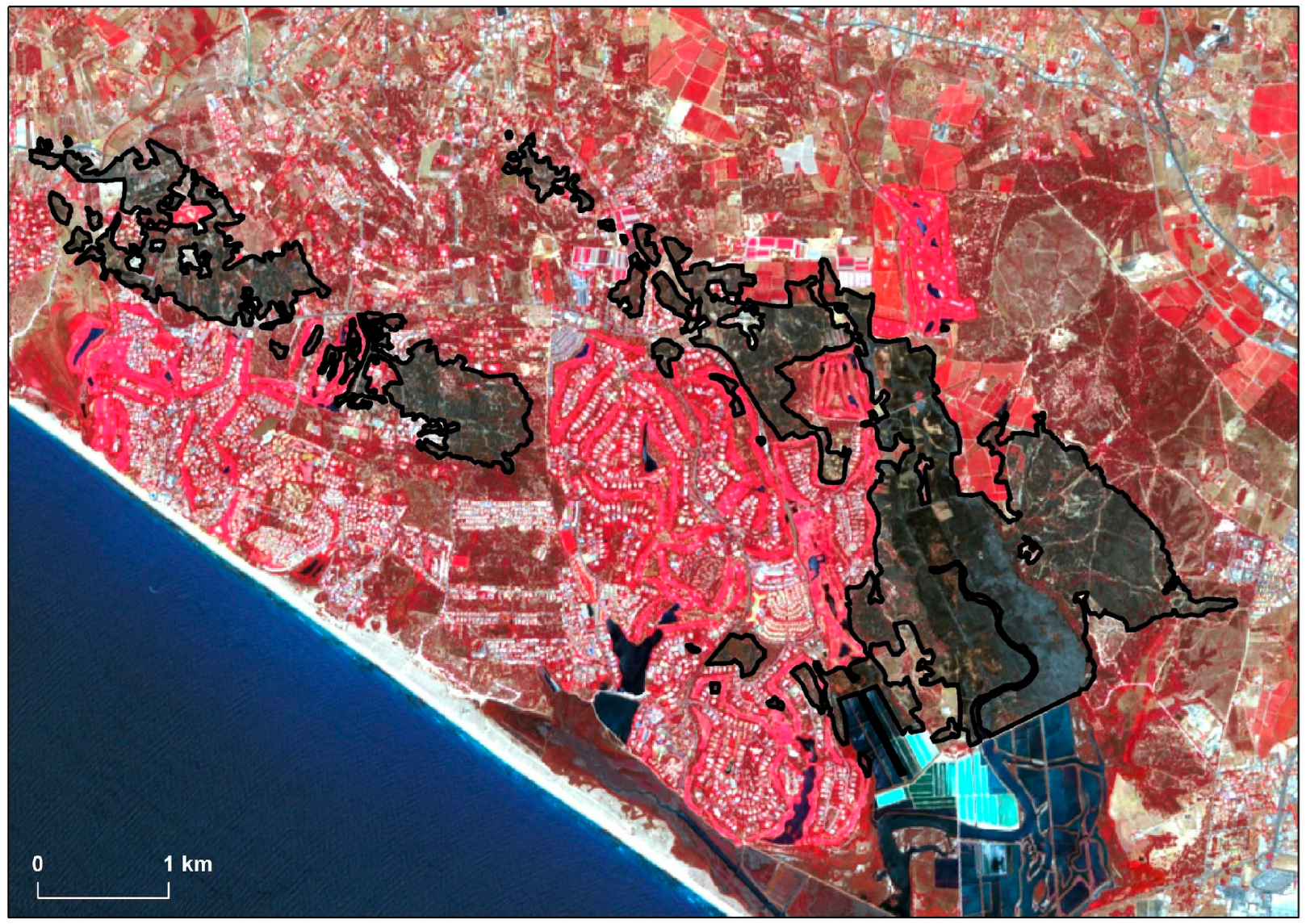
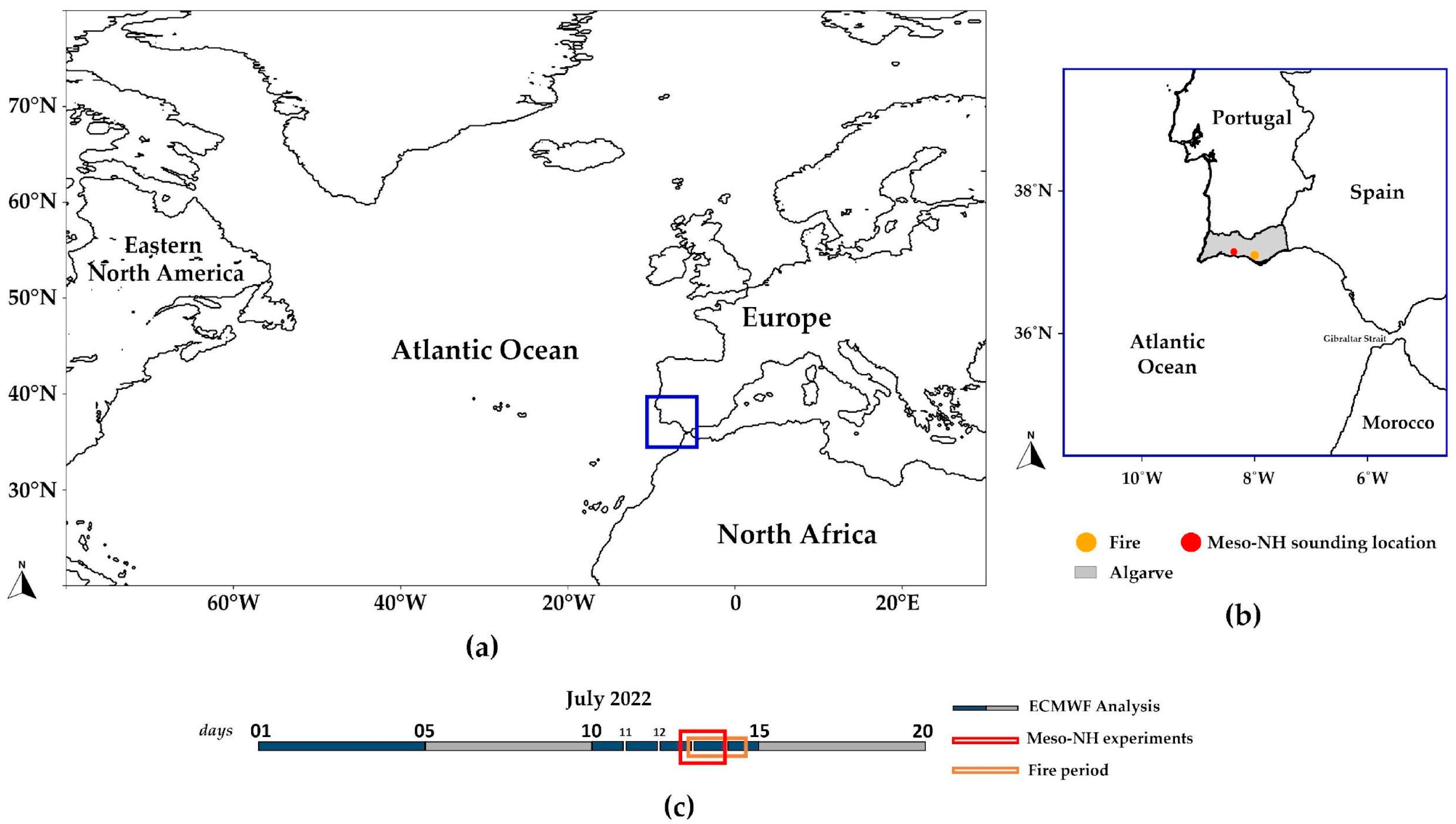
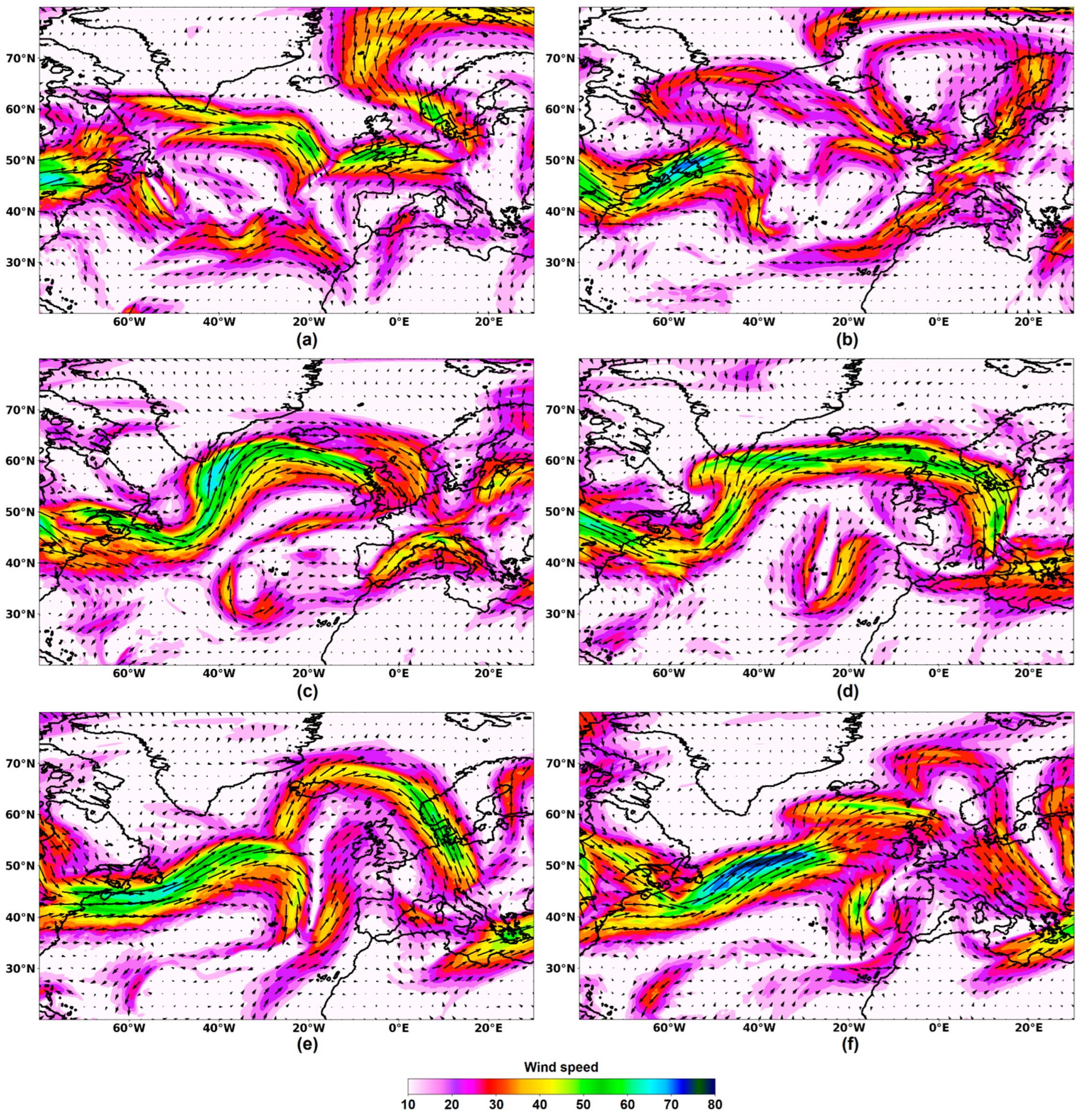
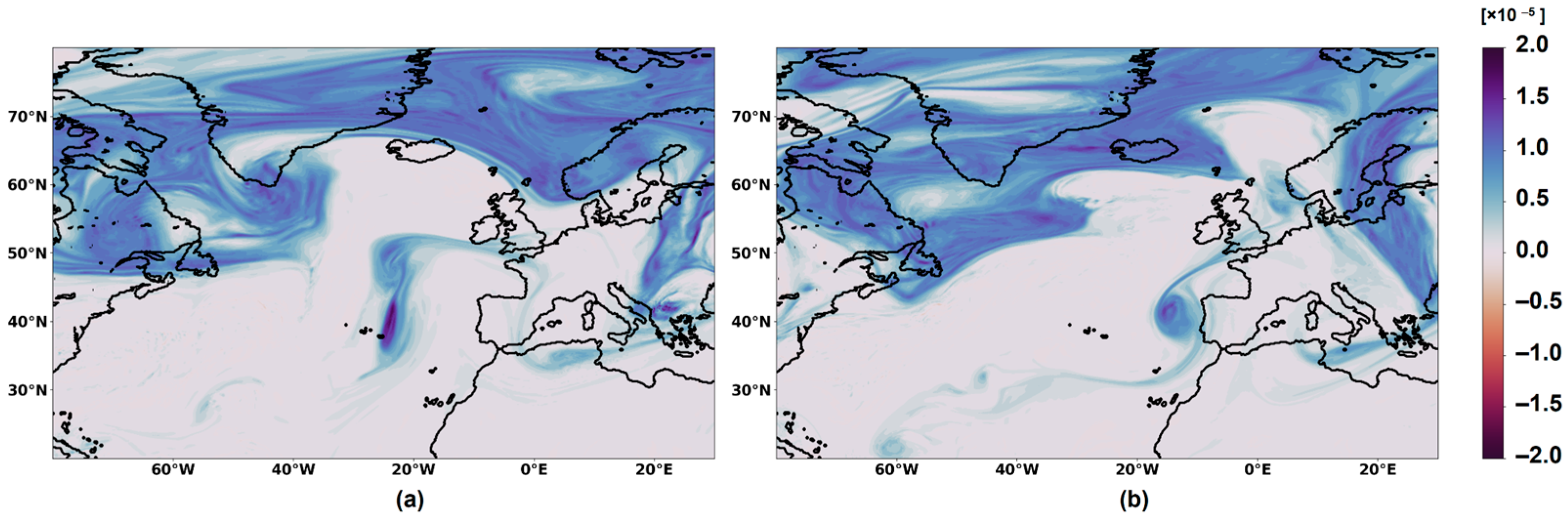

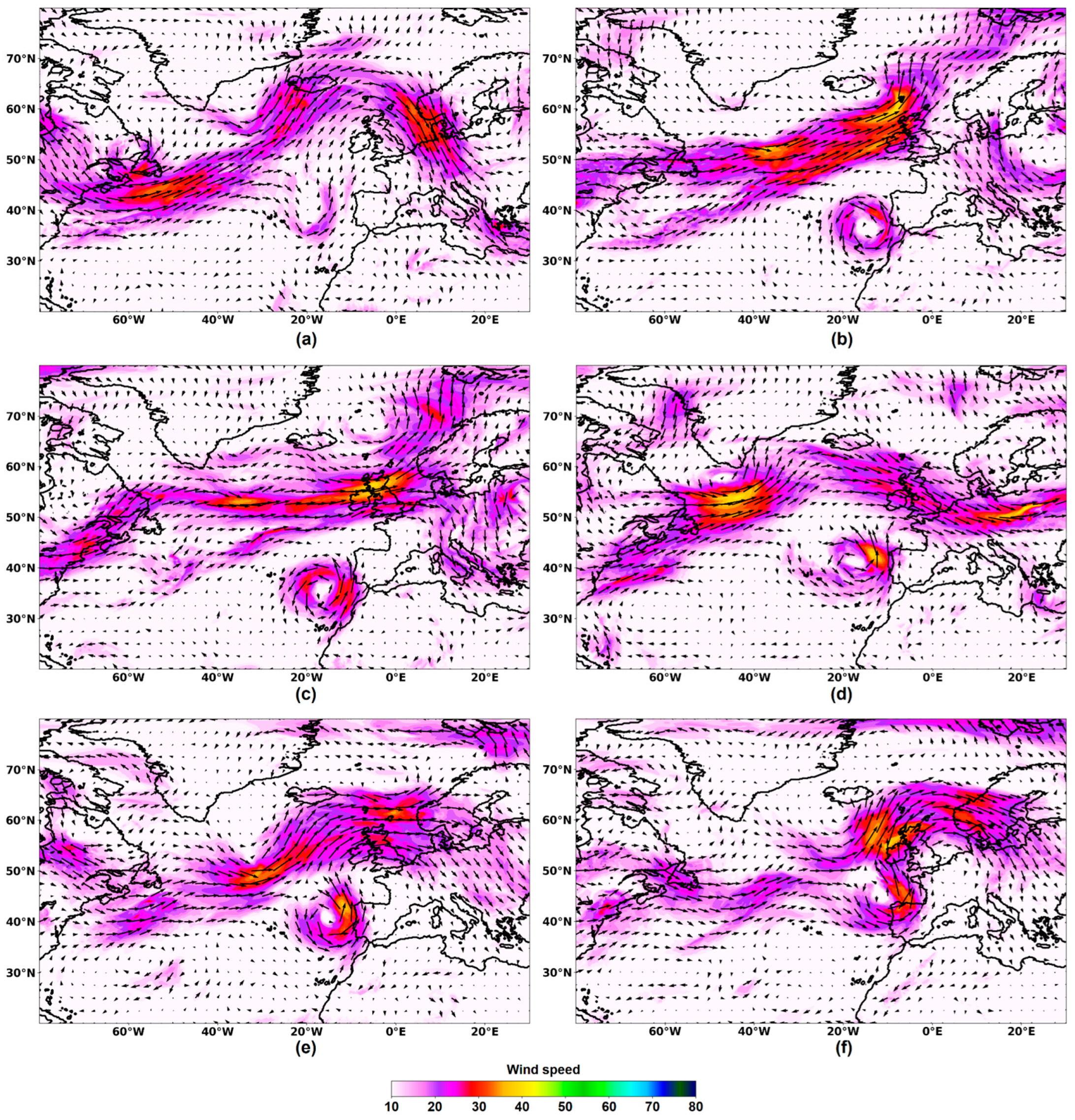
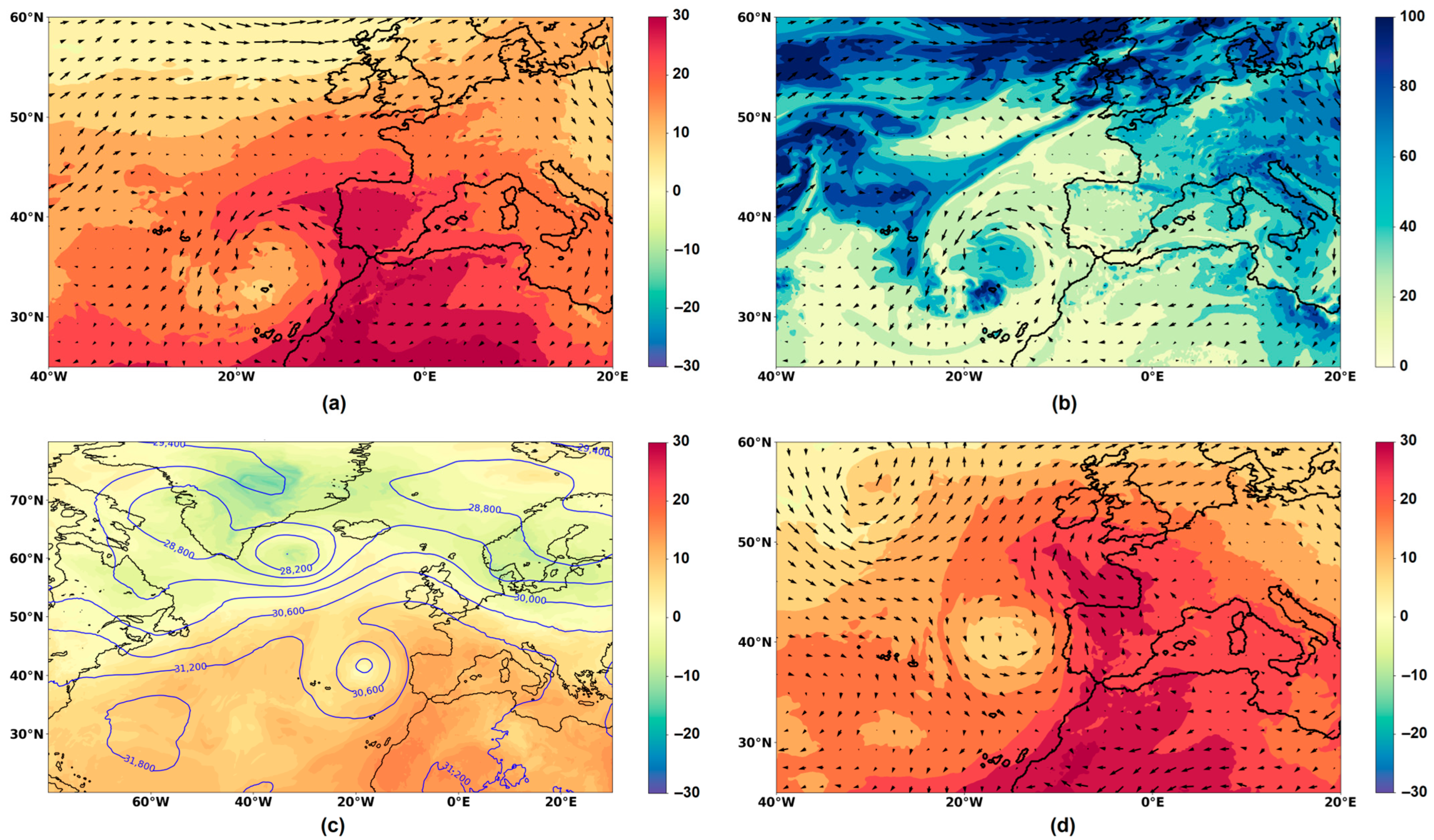
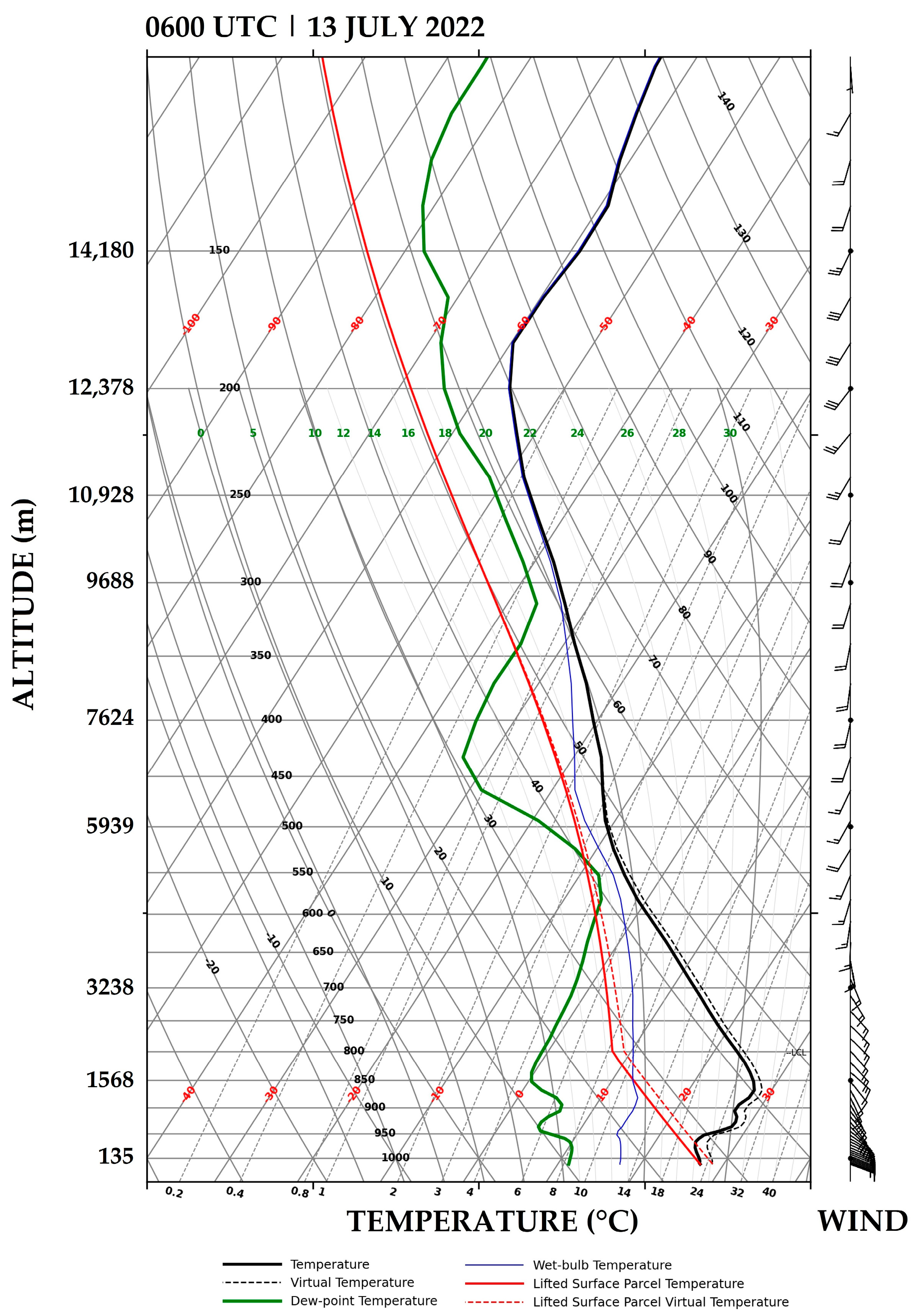


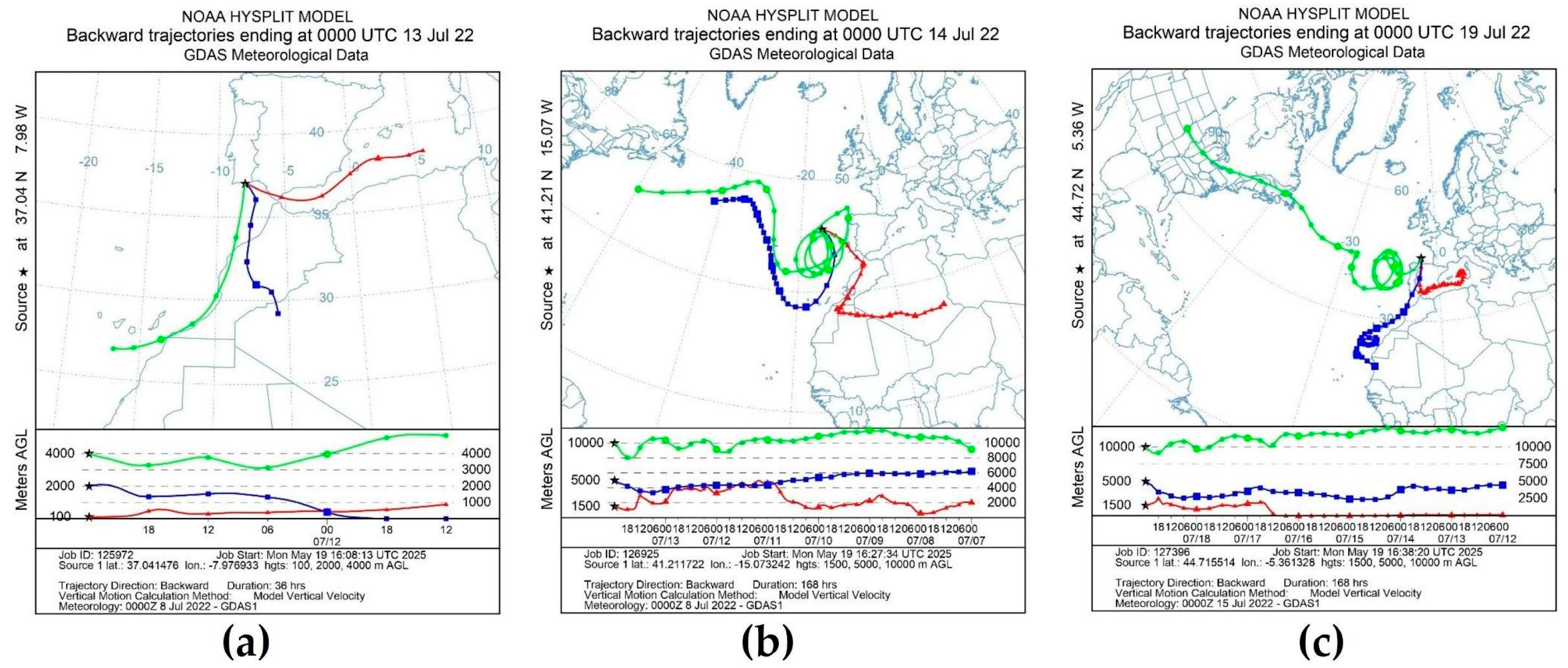
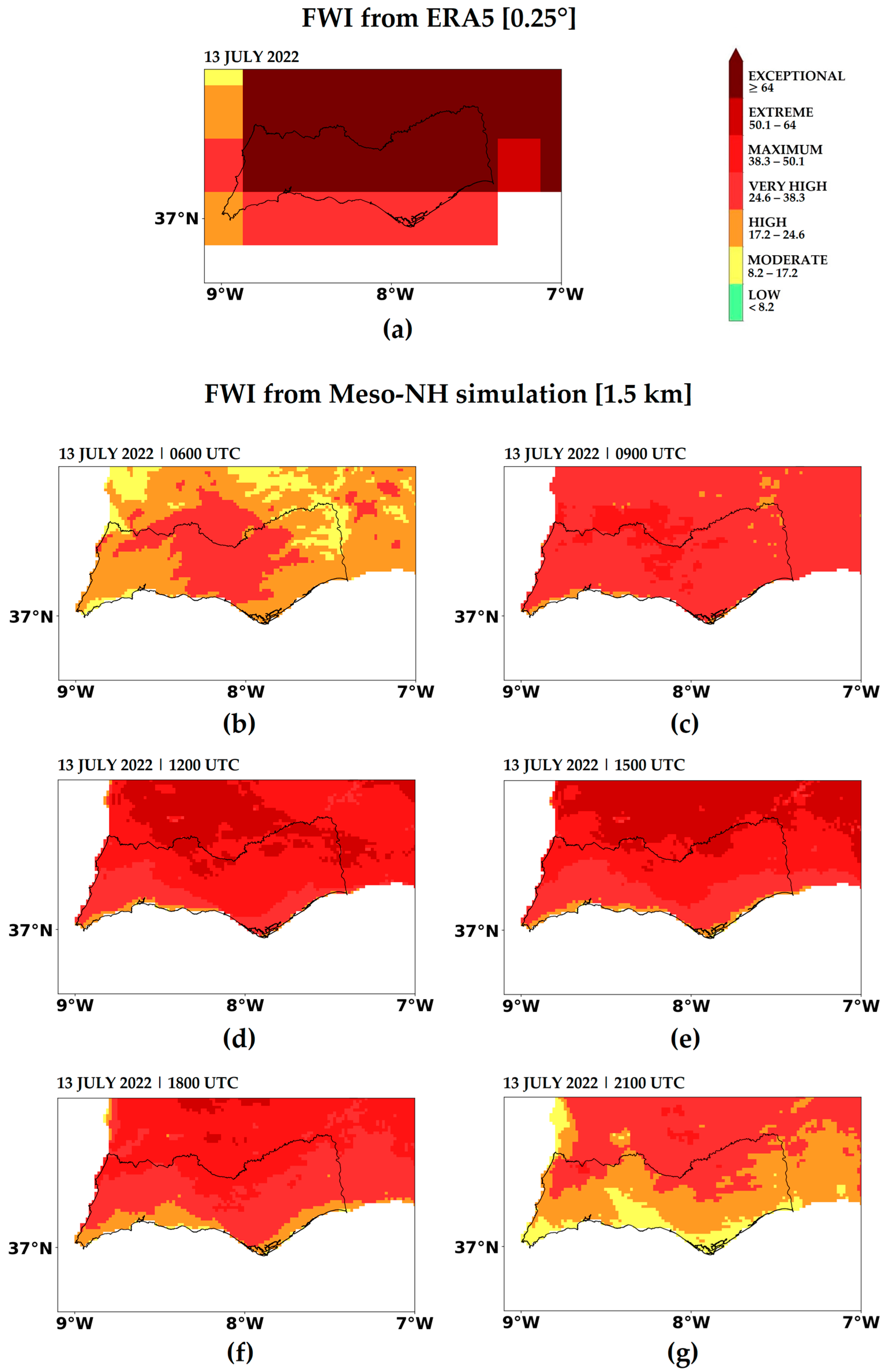
Disclaimer/Publisher’s Note: The statements, opinions and data contained in all publications are solely those of the individual author(s) and contributor(s) and not of MDPI and/or the editor(s). MDPI and/or the editor(s) disclaim responsibility for any injury to people or property resulting from any ideas, methods, instructions or products referred to in the content. |
© 2025 by the authors. Licensee MDPI, Basel, Switzerland. This article is an open access article distributed under the terms and conditions of the Creative Commons Attribution (CC BY) license (https://creativecommons.org/licenses/by/4.0/).
Share and Cite
Couto, F.T.; Campos, C.; Purificação, C.; Santos, F.L.M.; Andrade, H.N.; Andrade, N.; Nunes, A.B.; Guiomar, N.; Salgado, R. Synoptic and Regional Meteorological Drivers of a Wildfire in the Wildland–Urban Interface of Faro (Portugal). Fire 2025, 8, 362. https://doi.org/10.3390/fire8090362
Couto FT, Campos C, Purificação C, Santos FLM, Andrade HN, Andrade N, Nunes AB, Guiomar N, Salgado R. Synoptic and Regional Meteorological Drivers of a Wildfire in the Wildland–Urban Interface of Faro (Portugal). Fire. 2025; 8(9):362. https://doi.org/10.3390/fire8090362
Chicago/Turabian StyleCouto, Flavio Tiago, Cátia Campos, Carolina Purificação, Filippe Lemos Maia Santos, Hugo Nunes Andrade, Nuno Andrade, André Becker Nunes, Nuno Guiomar, and Rui Salgado. 2025. "Synoptic and Regional Meteorological Drivers of a Wildfire in the Wildland–Urban Interface of Faro (Portugal)" Fire 8, no. 9: 362. https://doi.org/10.3390/fire8090362
APA StyleCouto, F. T., Campos, C., Purificação, C., Santos, F. L. M., Andrade, H. N., Andrade, N., Nunes, A. B., Guiomar, N., & Salgado, R. (2025). Synoptic and Regional Meteorological Drivers of a Wildfire in the Wildland–Urban Interface of Faro (Portugal). Fire, 8(9), 362. https://doi.org/10.3390/fire8090362







